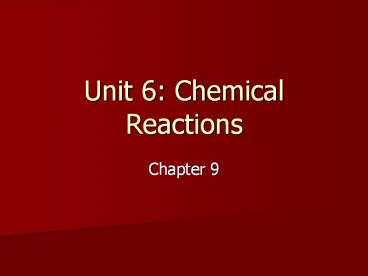Unit 6: Chemical Reactions - PowerPoint PPT Presentation
Title:
Unit 6: Chemical Reactions
Description:
The Nature of Chemical Reactions (9-1) A. Definition: process in which 1 or more ... Depends on: valence electrons & energy. II. Chemical Equations (9-2) ... – PowerPoint PPT presentation
Number of Views:102
Avg rating:3.0/5.0
Title: Unit 6: Chemical Reactions
1
Unit 6 Chemical Reactions
- Chapter 9
2
Unit 6 Chemical Reactions
- The Nature of Chemical Reactions (9-1)
- A. Definition process in which 1 or more
substances are converted to new substances with
different chemical and physical properties - B. Common Examples
- C. Components
- 1. Reactant substance that enters a chemical
reaction - 2. Product substance that is produced from a
chemical reaction
3
- D. Reason for Reactions
- Depends on valence electrons energy
- II. Chemical Equations (9-2)
- A. Definition sentences that represent
reactions - B. Indicates what substances are involved in
the reaction how many
4
- C. Types of Equations
- 1. Word Equations
- a. Name chemicals involved in the reaction
- b. Only a qualitative description
- Ex hydrogen oxygen ? water
- (reactants) (yields) (product)
- 2. Formula Equations
- a. Gives the formulas of the chemicals
involved and the ratios
5
- b. Gives a quantitative description
- Ex H2 O2 ? H2O
- (reactants) (yields) (product)
- This is not balanced, it must be! Why?
- Law of Conservation of Mass/Atoms in ordinary
chemical reactions - 1.) Total mass of reactants is equal to
total mass of products
6
- 2.) Number of elements for reactants is equal to
the number of elements for products - Atoms are not created nor destroyed, but they
simply rearrange. - Coefficients numbers in front of the formulas
in chemical equations that give the ratios of the
substances involved in the reaction
7
- Ex 2H2 O2 ---gt 2H2O
- 2 molecules 1 molecule 2 molecules
- or
- 2 moles 1 mole 2 moles
- Ex Interpret the following chemical reaction
- 2 NaI Cl2 ---gt 2NaCl I2
- Note What is the difference between 2CO and
CO2
8
- D. Writing and Balancing Chemical Equations
- 1. Review Indicate how many atoms of each
element are present in the following - a. 5NH3 ---gt
- b. 4Ca(OH)2 ---gt
- c. 3BaSO4 ---gt
9
- 2. Review Diatomics (H2,O2,N2,Cl2,F2,Br2,I2)
- Exist as a molecule of 2 atoms when they are by
themselves (natural/elemental form) - 3. Steps to writing chemical equations
- a. Write the correct chemical formulas for
compounds involved in the reaction - All compounds should have a neutral charge-
subscripts are used to balance the charge on
ionic compounds
10
- b. Balance equation according to the law of
conservation of atoms coefficients are used - c. Indicate the phase of each compound
- (s) ---gt solid
- (l) ---gt liquid
- (g) ---gt gas
- (aq) ---gt solid salt dissolved in water
- d. Show the energy change in the equation
- Endothermic ---gt Energy written on left side
- Exothermic ---gt Energy written on right side
11
- III. Classifying Chemical Reactions (9-3)
- 1. Synthesis (S), Composition, or Direct
Combination two or more substances combine to
form a more complex substance - General Form A B ---gt AB
- Examples 2H2 O2 ---gt 2H2O
- 4Fe 3O2 ---gt 2Fe2O3 (rusting)
- 2CO O2 ---gt 2CO2
12
- 2. Decomposition (D) a complex substance breaks
down to form two or more simple substances - General Form AB ---gt A B
- Examples 2H2O ---gt 2H2 2O2
- 2KClO3 ---gt 2KCl 3O2
- 2HgO ---gt 2Hg O2
13
- 3. Single Replacement (SR) one element is
replaced in a compound by another element - General Form A BX ---gt AX B
- or
- Y BX ---gt BY X
- Examples Fe CuSO4 ---gt FeSO4 Cu
- Cl2 2KI ---gt 2KCl I2
- Cu AgNO3 ---gt CuNO3 Ag
14
- 4. Double Replacement (DR) or Ionic ionic
compounds swap partners/pairings - General Form AB XY ---gt AY XB
- Examples NaCl AgNO3 ---gt NaNO3 AgCl
- Ba(OH)2 NaBr --gt BaBr2 2NaOH
- (NH4)2CO3 CaCl2 --gt 2NH4Cl CaCO3































